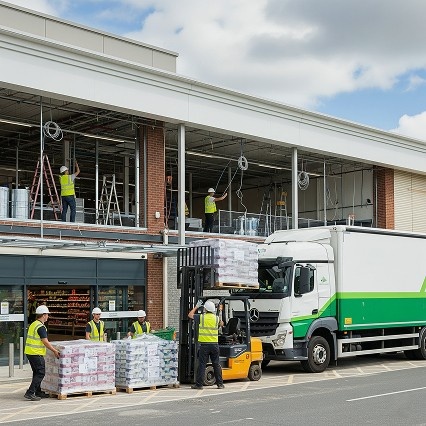In retail, time is money and nowhere is this truer than during a store refit. Whether it’s a complete renovation, a brand refresh, or a simple interior update, the longer your store remains closed, the more sales you lose and the more disruption you create for your customers. But there’s a powerful, often underappreciated factor that can drastically cut this downtime: logistics.
Smart logistics, the coordination of people, materials, equipment, and timelines can make the difference between a smooth, quick store transformation and a costly, chaotic shutdown. In this article, we’ll explore how logistics strategies help minimize store refit downtime and keep your retail business running efficiently.
1. The Importance of Minimizing Store Refit Downtime
Every hour your store is closed is an hour of lost revenue and missed opportunities. Beyond the direct financial impact, prolonged downtime can also:
- Frustrate loyal customers who may turn to competitors.
- Delay new product launches or seasonal promotions.
- Increase project costs due to extended labour, storage, or rental needs.
That’s why retailers increasingly focus on streamlined logistics planning ensuring that every stage of a refit project runs like clockwork to reduce closures and reopen doors sooner.
2. Strategic Planning: The Foundation of Reduced Downtime
The secret to minimizing downtime begins long before construction starts. Effective logistics planning ensures that every moving part, materials, equipment, personnel, and schedules is synchronized.
1. Pre-Refit Assessment
- Conduct a site survey to understand the existing layout, potential obstacles, and specific project needs.
- Define the scope of work clearly, including timelines, budgets, and phases.
- Identify potential risks or delays (e.g., supply chain issues, permit approvals) early in the process.
2. Project Phasing
Rather than shutting down the entire store, many retailers use a phased refit strategy renovating one section at a time while keeping the rest operational.
- Phase 1: Storage and back-end upgrades
- Phase 2: Customer-facing areas
- Phase 3: Final finishes and testing
This approach, combined with tight logistics coordination, keeps downtime and revenue loss to a minimum.
3. Just-in-Time (JIT) Deliveries: Streamlining Material Flow
One of the most common causes of refit delays is poor material scheduling. Delivering equipment too early leads to storage issues, while late arrivals stall progress. A just-in-time (JIT) logistics model solves this problem.
1. Benefits of JIT Deliveries
- Reduced storage costs: No need for expensive on-site warehousing.
- Less clutter: A safer, more efficient work environment.
- Continuous workflow: Materials and equipment arrive exactly when needed, keeping the project moving forward.
For example, shelving units, lighting fixtures, or digital signage can be delivered in sequence with installation phases, ensuring no part of the project is waiting on materials.
4. Coordinating Multi-Vendor Installations
Retail refits often involve multiple vendors electricians, flooring specialists, fixture installers, IT teams, and more. Without careful logistics coordination, their schedules can clash, causing unnecessary downtime.
1. Centralized Scheduling
A logistics manager or project coordinator should oversee all vendor timelines, ensuring tasks are sequenced properly. For example:
- Electrical and plumbing work before ceiling and flooring installation.
- Fixture installation before IT systems setup.
- Final signage and merchandising last.
This “critical path” planning ensures smooth transitions between teams and eliminates waiting periods.
5. Using Off-Site Preparation to Save Time On-Site
One of the smartest logistics tactics to reduce refit downtime is pre-assembling and staging equipment off-site.
Instead of spending valuable hours on-site unpacking, assembling, and configuring equipment, many components from shelving systems to point-of-sale kiosks can be prepared in advance and delivered ready to install.
1. Off-Site Advantages
- Shorter installation times: Equipment is plug-and-play on arrival.
- Fewer on-site errors: Pre-testing reduces last-minute technical issues.
- Improved quality control: Issues are resolved before materials reach the store.
Also, learn more about the The Power of Mounted Forklift Delivery (Internal Blog Link)
6. Overnight and Out-of-Hours Installations
For retailers who can’t afford to close during business hours, logistics can make round-the-clock work possible. Nighttime or off-hours installations keep the store open while work progresses behind the scenes.
- Teams arrive after closing and complete tasks overnight.
- Deliveries are scheduled during low-traffic periods to avoid disruptions.
- Temporary walls or partitions protect customers and staff during partial renovations.
This approach requires meticulous logistics coordination but can significantly reduce or even eliminate downtime.
7. Real-Time Tracking and Communication Tools
Modern logistics solutions use digital platforms to track materials, monitor schedules, and communicate updates in real time. This technology-driven approach helps teams respond quickly to delays, reroute deliveries, or reassign resources as needed.
1. Examples of Smart Logistics Tools
- GPS-enabled tracking for equipment and materials
- Project management platforms (e.g., Asana, Monday.com) for timeline coordination
- Cloud-based dashboards to give stakeholders live updates
The result: faster decision-making, fewer delays, and a smoother refit process.
8. Post-Refit Logistics: Faster Store Reopenings
Once installations are complete, logistics still play a vital role in getting the store operational quickly. Final steps include:
- Rapid clean-up and waste removal
- Merchandise restocking timed precisely for reopening
- Coordinated equipment testing and training for staff
A well-executed final logistics plan ensures that your store transitions seamlessly from construction site to customer-ready retail space.
Final Thoughts
Minimizing store refit downtime isn’t about cutting corners, it’s about working smarter. Strategic logistics planning keeps projects on schedule, materials flowing smoothly, and teams working in harmony. From pre-installation assessments to just-in-time deliveries and off-site preparation, every logistics decision plays a role in reducing downtime and protecting revenue.In today’s competitive retail landscape, where customer loyalty and brand image are tied to convenience and availability, efficient logistics can mean the difference between a successful refit and a costly disruption. By investing in the right logistics strategies, retailers can transform their stores quickly, reopen faster, and stay one step ahead of the competition.

